Consumer Behaviour and Decision Making in Tourism (L5) Report
VerifiedAdded on 2023/01/11
|12
|4155
|71
Report
AI Summary
This report delves into the realm of tourism consumer behavior, focusing on the strategies employed by Kirker Holidays, a prominent UK-based tourism business. The report examines various factors influencing consumer attitudes and behaviors, including cultural, social, personal, and psychological influences. It also explores the impact of digital technology on consumer trends, such as the convenience of smart devices and the importance of fulfilling experiences. The report further analyzes the stages of consumer decision-making, from need recognition to post-purchase behavior, and emphasizes the importance of marketers mapping the purchase path. A comparison between B2B and B2C decision-making in the hospitality sector is presented. Finally, the report evaluates the ways marketers influence each stage of the consumer decision-making process and provides an overview of marketing mix elements.
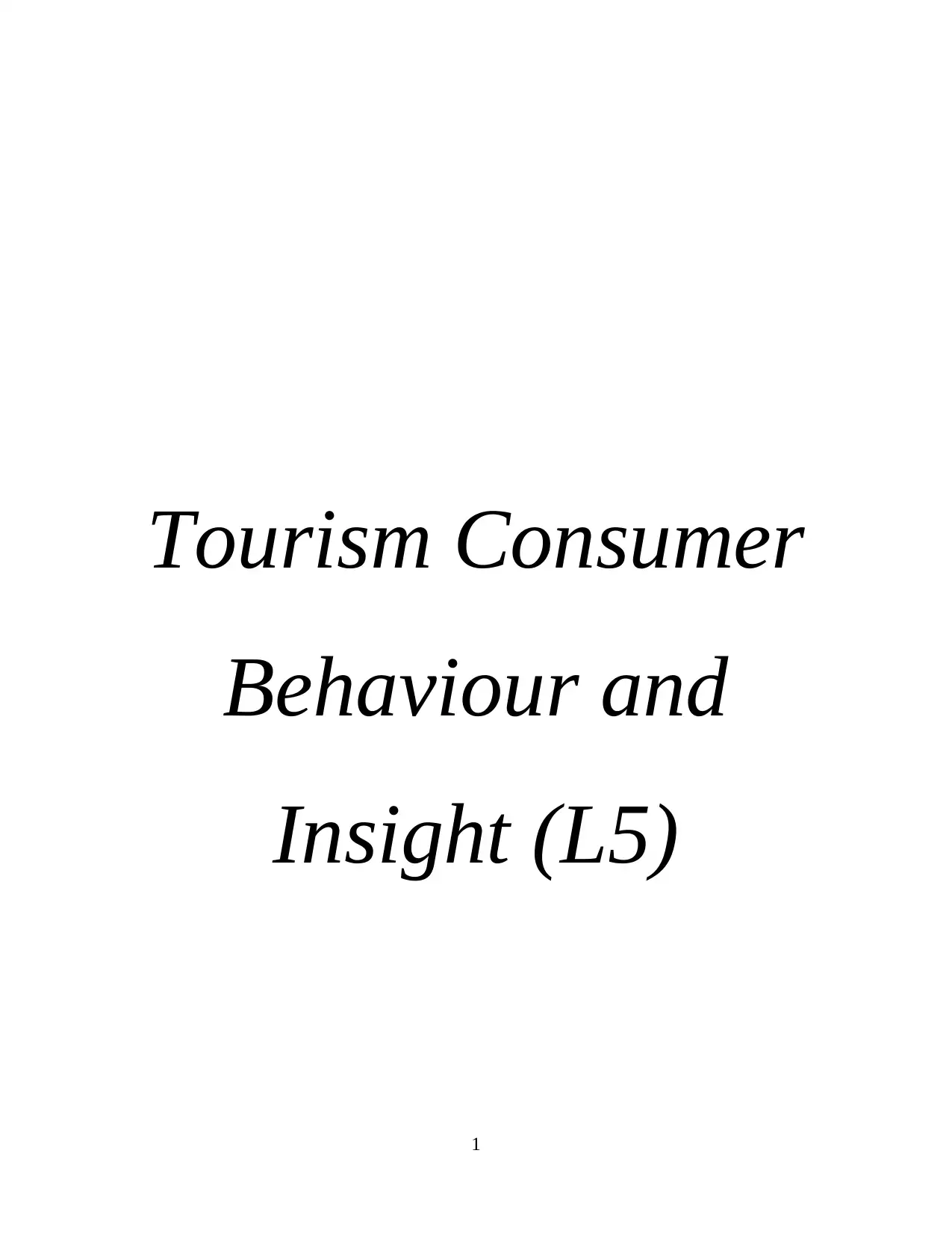
Tourism Consumer
Behaviour and
Insight (L5)
1
Behaviour and
Insight (L5)
1
Paraphrase This Document
Need a fresh take? Get an instant paraphrase of this document with our AI Paraphraser
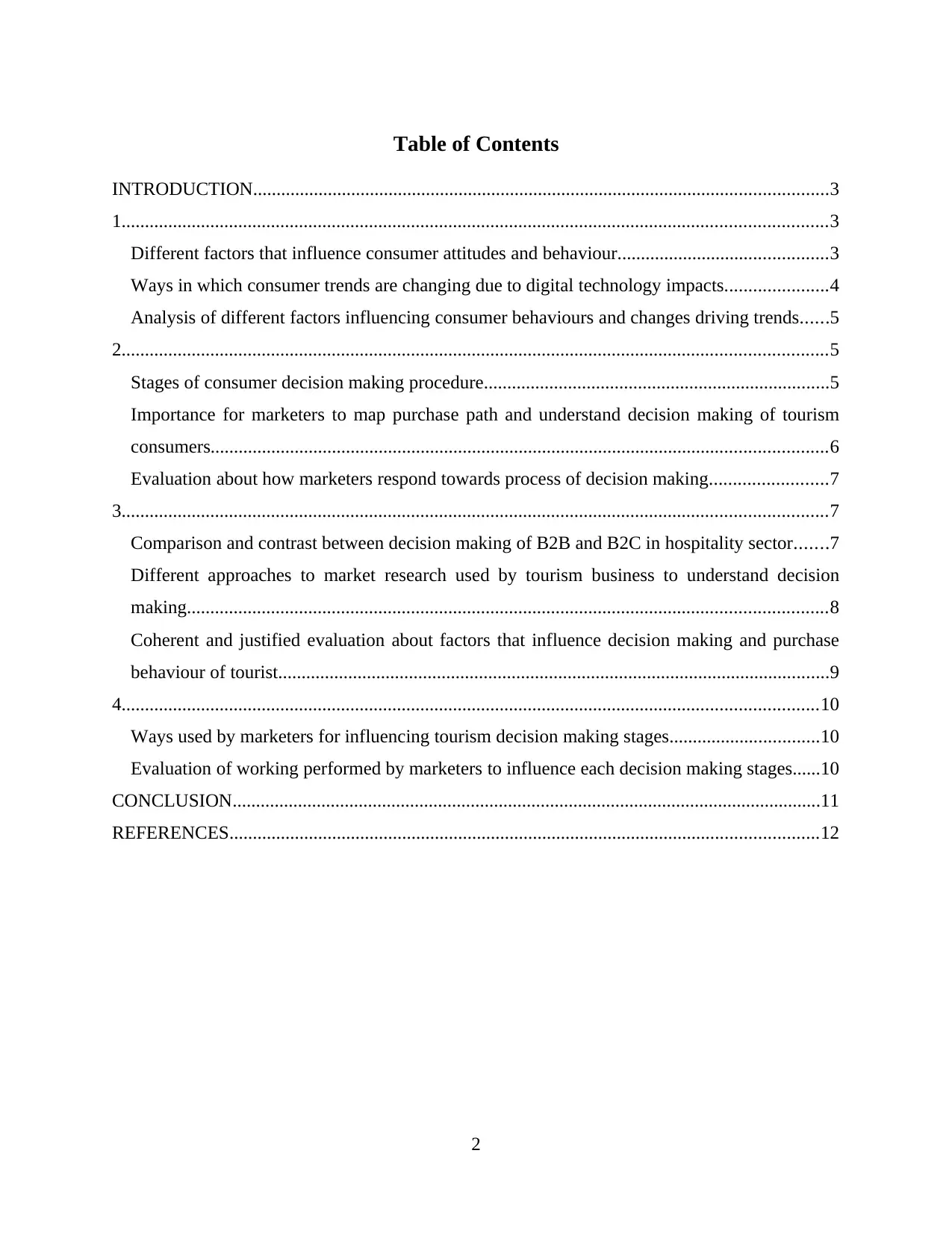
Table of Contents
INTRODUCTION...........................................................................................................................3
1.......................................................................................................................................................3
Different factors that influence consumer attitudes and behaviour.............................................3
Ways in which consumer trends are changing due to digital technology impacts......................4
Analysis of different factors influencing consumer behaviours and changes driving trends......5
2.......................................................................................................................................................5
Stages of consumer decision making procedure..........................................................................5
Importance for marketers to map purchase path and understand decision making of tourism
consumers....................................................................................................................................6
Evaluation about how marketers respond towards process of decision making.........................7
3.......................................................................................................................................................7
Comparison and contrast between decision making of B2B and B2C in hospitality sector.......7
Different approaches to market research used by tourism business to understand decision
making.........................................................................................................................................8
Coherent and justified evaluation about factors that influence decision making and purchase
behaviour of tourist......................................................................................................................9
4.....................................................................................................................................................10
Ways used by marketers for influencing tourism decision making stages................................10
Evaluation of working performed by marketers to influence each decision making stages......10
CONCLUSION..............................................................................................................................11
REFERENCES..............................................................................................................................12
2
INTRODUCTION...........................................................................................................................3
1.......................................................................................................................................................3
Different factors that influence consumer attitudes and behaviour.............................................3
Ways in which consumer trends are changing due to digital technology impacts......................4
Analysis of different factors influencing consumer behaviours and changes driving trends......5
2.......................................................................................................................................................5
Stages of consumer decision making procedure..........................................................................5
Importance for marketers to map purchase path and understand decision making of tourism
consumers....................................................................................................................................6
Evaluation about how marketers respond towards process of decision making.........................7
3.......................................................................................................................................................7
Comparison and contrast between decision making of B2B and B2C in hospitality sector.......7
Different approaches to market research used by tourism business to understand decision
making.........................................................................................................................................8
Coherent and justified evaluation about factors that influence decision making and purchase
behaviour of tourist......................................................................................................................9
4.....................................................................................................................................................10
Ways used by marketers for influencing tourism decision making stages................................10
Evaluation of working performed by marketers to influence each decision making stages......10
CONCLUSION..............................................................................................................................11
REFERENCES..............................................................................................................................12
2
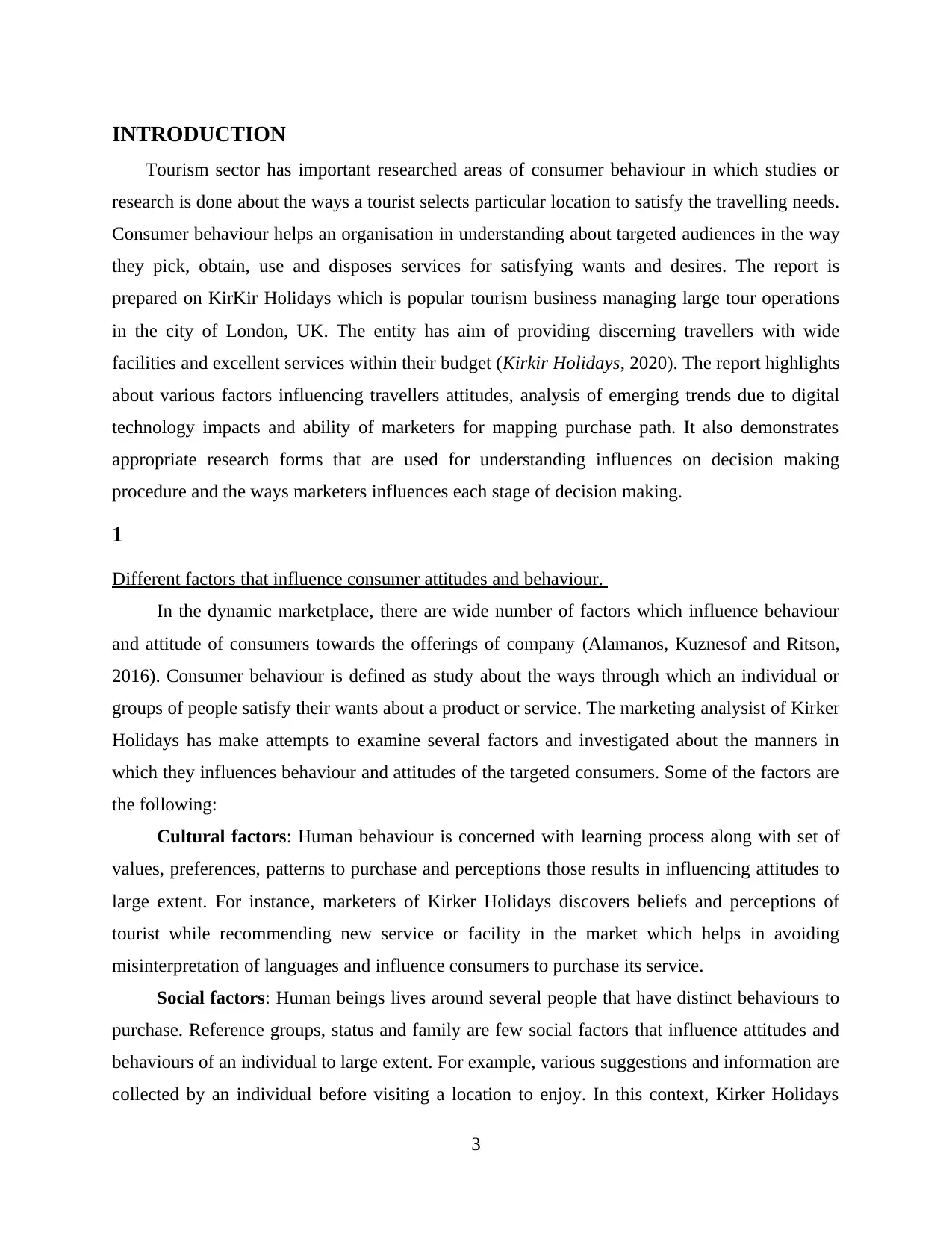
INTRODUCTION
Tourism sector has important researched areas of consumer behaviour in which studies or
research is done about the ways a tourist selects particular location to satisfy the travelling needs.
Consumer behaviour helps an organisation in understanding about targeted audiences in the way
they pick, obtain, use and disposes services for satisfying wants and desires. The report is
prepared on KirKir Holidays which is popular tourism business managing large tour operations
in the city of London, UK. The entity has aim of providing discerning travellers with wide
facilities and excellent services within their budget (Kirkir Holidays, 2020). The report highlights
about various factors influencing travellers attitudes, analysis of emerging trends due to digital
technology impacts and ability of marketers for mapping purchase path. It also demonstrates
appropriate research forms that are used for understanding influences on decision making
procedure and the ways marketers influences each stage of decision making.
1
Different factors that influence consumer attitudes and behaviour.
In the dynamic marketplace, there are wide number of factors which influence behaviour
and attitude of consumers towards the offerings of company (Alamanos, Kuznesof and Ritson,
2016). Consumer behaviour is defined as study about the ways through which an individual or
groups of people satisfy their wants about a product or service. The marketing analysist of Kirker
Holidays has make attempts to examine several factors and investigated about the manners in
which they influences behaviour and attitudes of the targeted consumers. Some of the factors are
the following:
Cultural factors: Human behaviour is concerned with learning process along with set of
values, preferences, patterns to purchase and perceptions those results in influencing attitudes to
large extent. For instance, marketers of Kirker Holidays discovers beliefs and perceptions of
tourist while recommending new service or facility in the market which helps in avoiding
misinterpretation of languages and influence consumers to purchase its service.
Social factors: Human beings lives around several people that have distinct behaviours to
purchase. Reference groups, status and family are few social factors that influence attitudes and
behaviours of an individual to large extent. For example, various suggestions and information are
collected by an individual before visiting a location to enjoy. In this context, Kirker Holidays
3
Tourism sector has important researched areas of consumer behaviour in which studies or
research is done about the ways a tourist selects particular location to satisfy the travelling needs.
Consumer behaviour helps an organisation in understanding about targeted audiences in the way
they pick, obtain, use and disposes services for satisfying wants and desires. The report is
prepared on KirKir Holidays which is popular tourism business managing large tour operations
in the city of London, UK. The entity has aim of providing discerning travellers with wide
facilities and excellent services within their budget (Kirkir Holidays, 2020). The report highlights
about various factors influencing travellers attitudes, analysis of emerging trends due to digital
technology impacts and ability of marketers for mapping purchase path. It also demonstrates
appropriate research forms that are used for understanding influences on decision making
procedure and the ways marketers influences each stage of decision making.
1
Different factors that influence consumer attitudes and behaviour.
In the dynamic marketplace, there are wide number of factors which influence behaviour
and attitude of consumers towards the offerings of company (Alamanos, Kuznesof and Ritson,
2016). Consumer behaviour is defined as study about the ways through which an individual or
groups of people satisfy their wants about a product or service. The marketing analysist of Kirker
Holidays has make attempts to examine several factors and investigated about the manners in
which they influences behaviour and attitudes of the targeted consumers. Some of the factors are
the following:
Cultural factors: Human behaviour is concerned with learning process along with set of
values, preferences, patterns to purchase and perceptions those results in influencing attitudes to
large extent. For instance, marketers of Kirker Holidays discovers beliefs and perceptions of
tourist while recommending new service or facility in the market which helps in avoiding
misinterpretation of languages and influence consumers to purchase its service.
Social factors: Human beings lives around several people that have distinct behaviours to
purchase. Reference groups, status and family are few social factors that influence attitudes and
behaviours of an individual to large extent. For example, various suggestions and information are
collected by an individual before visiting a location to enjoy. In this context, Kirker Holidays
3
⊘ This is a preview!⊘
Do you want full access?
Subscribe today to unlock all pages.

Trusted by 1+ million students worldwide
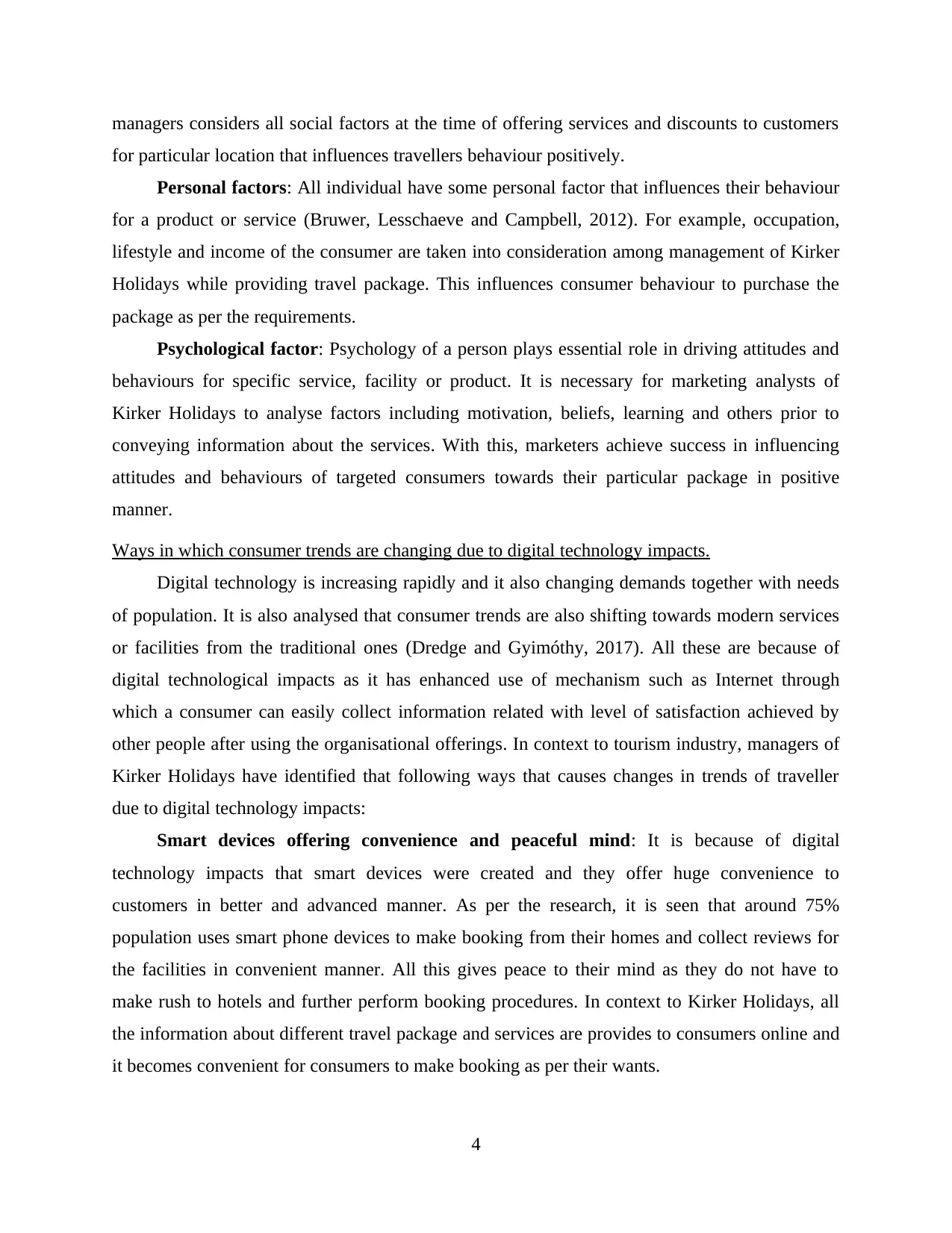
managers considers all social factors at the time of offering services and discounts to customers
for particular location that influences travellers behaviour positively.
Personal factors: All individual have some personal factor that influences their behaviour
for a product or service (Bruwer, Lesschaeve and Campbell, 2012). For example, occupation,
lifestyle and income of the consumer are taken into consideration among management of Kirker
Holidays while providing travel package. This influences consumer behaviour to purchase the
package as per the requirements.
Psychological factor: Psychology of a person plays essential role in driving attitudes and
behaviours for specific service, facility or product. It is necessary for marketing analysts of
Kirker Holidays to analyse factors including motivation, beliefs, learning and others prior to
conveying information about the services. With this, marketers achieve success in influencing
attitudes and behaviours of targeted consumers towards their particular package in positive
manner.
Ways in which consumer trends are changing due to digital technology impacts.
Digital technology is increasing rapidly and it also changing demands together with needs
of population. It is also analysed that consumer trends are also shifting towards modern services
or facilities from the traditional ones (Dredge and Gyimóthy, 2017). All these are because of
digital technological impacts as it has enhanced use of mechanism such as Internet through
which a consumer can easily collect information related with level of satisfaction achieved by
other people after using the organisational offerings. In context to tourism industry, managers of
Kirker Holidays have identified that following ways that causes changes in trends of traveller
due to digital technology impacts:
Smart devices offering convenience and peaceful mind: It is because of digital
technology impacts that smart devices were created and they offer huge convenience to
customers in better and advanced manner. As per the research, it is seen that around 75%
population uses smart phone devices to make booking from their homes and collect reviews for
the facilities in convenient manner. All this gives peace to their mind as they do not have to
make rush to hotels and further perform booking procedures. In context to Kirker Holidays, all
the information about different travel package and services are provides to consumers online and
it becomes convenient for consumers to make booking as per their wants.
4
for particular location that influences travellers behaviour positively.
Personal factors: All individual have some personal factor that influences their behaviour
for a product or service (Bruwer, Lesschaeve and Campbell, 2012). For example, occupation,
lifestyle and income of the consumer are taken into consideration among management of Kirker
Holidays while providing travel package. This influences consumer behaviour to purchase the
package as per the requirements.
Psychological factor: Psychology of a person plays essential role in driving attitudes and
behaviours for specific service, facility or product. It is necessary for marketing analysts of
Kirker Holidays to analyse factors including motivation, beliefs, learning and others prior to
conveying information about the services. With this, marketers achieve success in influencing
attitudes and behaviours of targeted consumers towards their particular package in positive
manner.
Ways in which consumer trends are changing due to digital technology impacts.
Digital technology is increasing rapidly and it also changing demands together with needs
of population. It is also analysed that consumer trends are also shifting towards modern services
or facilities from the traditional ones (Dredge and Gyimóthy, 2017). All these are because of
digital technological impacts as it has enhanced use of mechanism such as Internet through
which a consumer can easily collect information related with level of satisfaction achieved by
other people after using the organisational offerings. In context to tourism industry, managers of
Kirker Holidays have identified that following ways that causes changes in trends of traveller
due to digital technology impacts:
Smart devices offering convenience and peaceful mind: It is because of digital
technology impacts that smart devices were created and they offer huge convenience to
customers in better and advanced manner. As per the research, it is seen that around 75%
population uses smart phone devices to make booking from their homes and collect reviews for
the facilities in convenient manner. All this gives peace to their mind as they do not have to
make rush to hotels and further perform booking procedures. In context to Kirker Holidays, all
the information about different travel package and services are provides to consumers online and
it becomes convenient for consumers to make booking as per their wants.
4
Paraphrase This Document
Need a fresh take? Get an instant paraphrase of this document with our AI Paraphraser
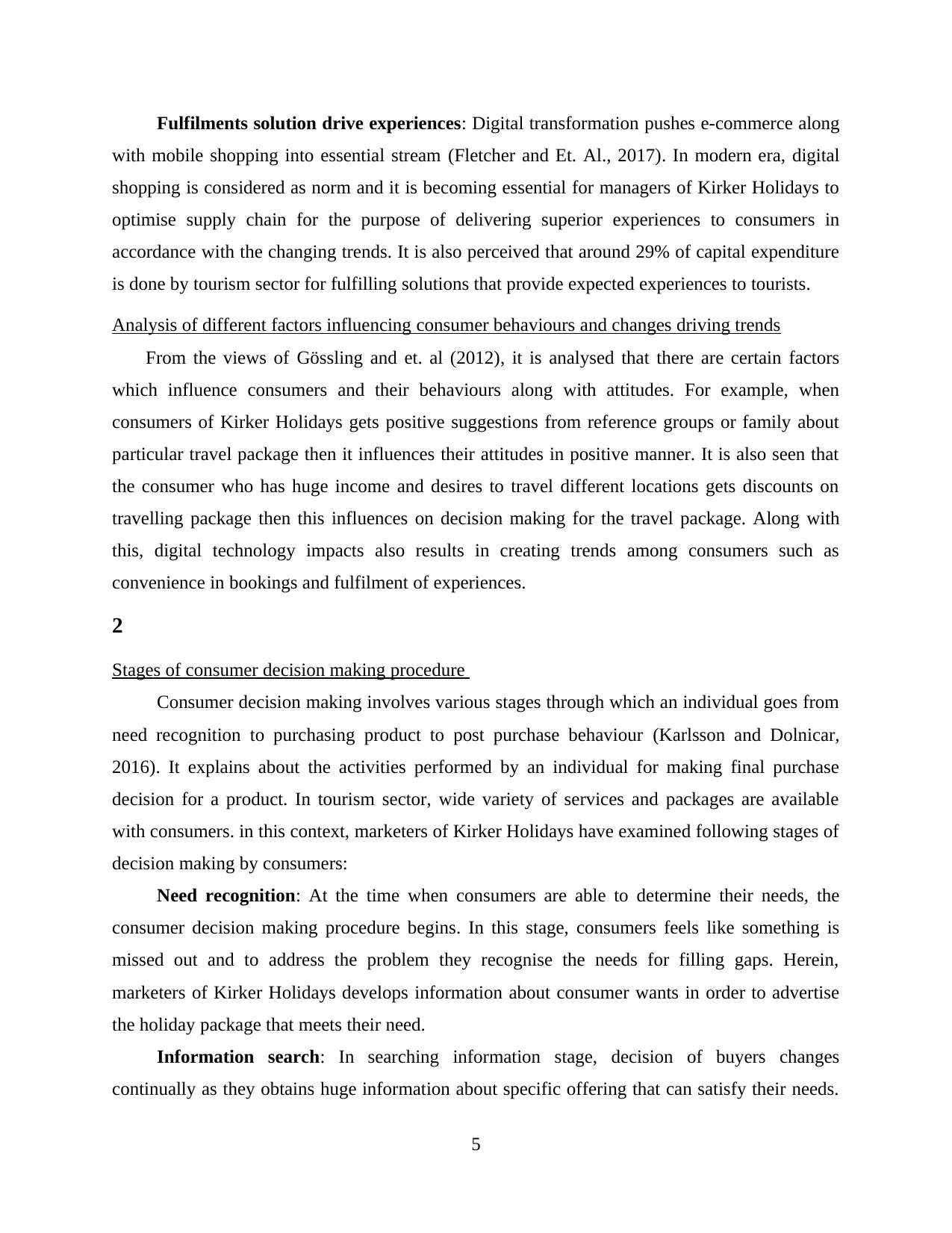
Fulfilments solution drive experiences: Digital transformation pushes e-commerce along
with mobile shopping into essential stream (Fletcher and Et. Al., 2017). In modern era, digital
shopping is considered as norm and it is becoming essential for managers of Kirker Holidays to
optimise supply chain for the purpose of delivering superior experiences to consumers in
accordance with the changing trends. It is also perceived that around 29% of capital expenditure
is done by tourism sector for fulfilling solutions that provide expected experiences to tourists.
Analysis of different factors influencing consumer behaviours and changes driving trends
From the views of Gössling and et. al (2012), it is analysed that there are certain factors
which influence consumers and their behaviours along with attitudes. For example, when
consumers of Kirker Holidays gets positive suggestions from reference groups or family about
particular travel package then it influences their attitudes in positive manner. It is also seen that
the consumer who has huge income and desires to travel different locations gets discounts on
travelling package then this influences on decision making for the travel package. Along with
this, digital technology impacts also results in creating trends among consumers such as
convenience in bookings and fulfilment of experiences.
2
Stages of consumer decision making procedure
Consumer decision making involves various stages through which an individual goes from
need recognition to purchasing product to post purchase behaviour (Karlsson and Dolnicar,
2016). It explains about the activities performed by an individual for making final purchase
decision for a product. In tourism sector, wide variety of services and packages are available
with consumers. in this context, marketers of Kirker Holidays have examined following stages of
decision making by consumers:
Need recognition: At the time when consumers are able to determine their needs, the
consumer decision making procedure begins. In this stage, consumers feels like something is
missed out and to address the problem they recognise the needs for filling gaps. Herein,
marketers of Kirker Holidays develops information about consumer wants in order to advertise
the holiday package that meets their need.
Information search: In searching information stage, decision of buyers changes
continually as they obtains huge information about specific offering that can satisfy their needs.
5
with mobile shopping into essential stream (Fletcher and Et. Al., 2017). In modern era, digital
shopping is considered as norm and it is becoming essential for managers of Kirker Holidays to
optimise supply chain for the purpose of delivering superior experiences to consumers in
accordance with the changing trends. It is also perceived that around 29% of capital expenditure
is done by tourism sector for fulfilling solutions that provide expected experiences to tourists.
Analysis of different factors influencing consumer behaviours and changes driving trends
From the views of Gössling and et. al (2012), it is analysed that there are certain factors
which influence consumers and their behaviours along with attitudes. For example, when
consumers of Kirker Holidays gets positive suggestions from reference groups or family about
particular travel package then it influences their attitudes in positive manner. It is also seen that
the consumer who has huge income and desires to travel different locations gets discounts on
travelling package then this influences on decision making for the travel package. Along with
this, digital technology impacts also results in creating trends among consumers such as
convenience in bookings and fulfilment of experiences.
2
Stages of consumer decision making procedure
Consumer decision making involves various stages through which an individual goes from
need recognition to purchasing product to post purchase behaviour (Karlsson and Dolnicar,
2016). It explains about the activities performed by an individual for making final purchase
decision for a product. In tourism sector, wide variety of services and packages are available
with consumers. in this context, marketers of Kirker Holidays have examined following stages of
decision making by consumers:
Need recognition: At the time when consumers are able to determine their needs, the
consumer decision making procedure begins. In this stage, consumers feels like something is
missed out and to address the problem they recognise the needs for filling gaps. Herein,
marketers of Kirker Holidays develops information about consumer wants in order to advertise
the holiday package that meets their need.
Information search: In searching information stage, decision of buyers changes
continually as they obtains huge information about specific offering that can satisfy their needs.
5
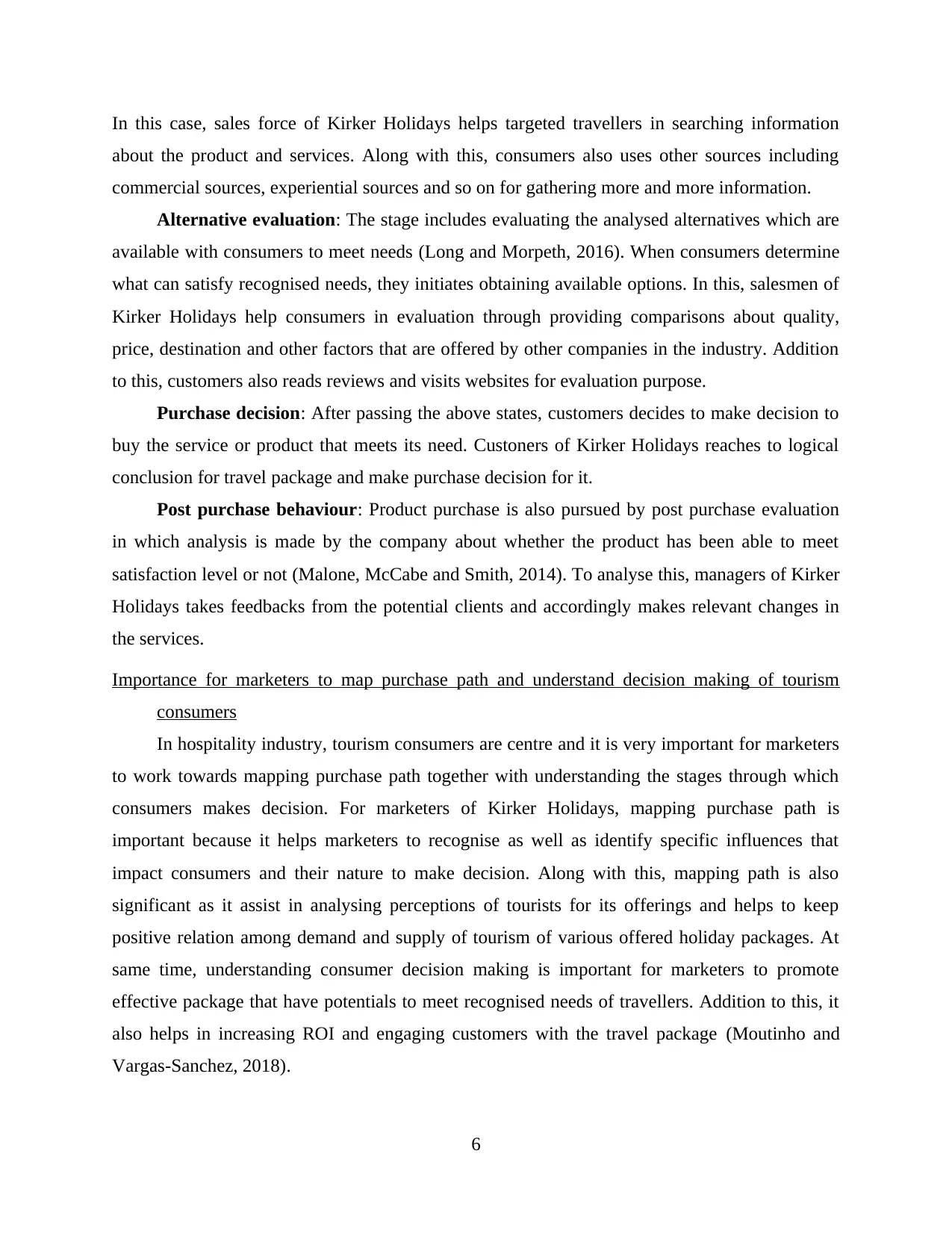
In this case, sales force of Kirker Holidays helps targeted travellers in searching information
about the product and services. Along with this, consumers also uses other sources including
commercial sources, experiential sources and so on for gathering more and more information.
Alternative evaluation: The stage includes evaluating the analysed alternatives which are
available with consumers to meet needs (Long and Morpeth, 2016). When consumers determine
what can satisfy recognised needs, they initiates obtaining available options. In this, salesmen of
Kirker Holidays help consumers in evaluation through providing comparisons about quality,
price, destination and other factors that are offered by other companies in the industry. Addition
to this, customers also reads reviews and visits websites for evaluation purpose.
Purchase decision: After passing the above states, customers decides to make decision to
buy the service or product that meets its need. Custoners of Kirker Holidays reaches to logical
conclusion for travel package and make purchase decision for it.
Post purchase behaviour: Product purchase is also pursued by post purchase evaluation
in which analysis is made by the company about whether the product has been able to meet
satisfaction level or not (Malone, McCabe and Smith, 2014). To analyse this, managers of Kirker
Holidays takes feedbacks from the potential clients and accordingly makes relevant changes in
the services.
Importance for marketers to map purchase path and understand decision making of tourism
consumers
In hospitality industry, tourism consumers are centre and it is very important for marketers
to work towards mapping purchase path together with understanding the stages through which
consumers makes decision. For marketers of Kirker Holidays, mapping purchase path is
important because it helps marketers to recognise as well as identify specific influences that
impact consumers and their nature to make decision. Along with this, mapping path is also
significant as it assist in analysing perceptions of tourists for its offerings and helps to keep
positive relation among demand and supply of tourism of various offered holiday packages. At
same time, understanding consumer decision making is important for marketers to promote
effective package that have potentials to meet recognised needs of travellers. Addition to this, it
also helps in increasing ROI and engaging customers with the travel package (Moutinho and
Vargas-Sanchez, 2018).
6
about the product and services. Along with this, consumers also uses other sources including
commercial sources, experiential sources and so on for gathering more and more information.
Alternative evaluation: The stage includes evaluating the analysed alternatives which are
available with consumers to meet needs (Long and Morpeth, 2016). When consumers determine
what can satisfy recognised needs, they initiates obtaining available options. In this, salesmen of
Kirker Holidays help consumers in evaluation through providing comparisons about quality,
price, destination and other factors that are offered by other companies in the industry. Addition
to this, customers also reads reviews and visits websites for evaluation purpose.
Purchase decision: After passing the above states, customers decides to make decision to
buy the service or product that meets its need. Custoners of Kirker Holidays reaches to logical
conclusion for travel package and make purchase decision for it.
Post purchase behaviour: Product purchase is also pursued by post purchase evaluation
in which analysis is made by the company about whether the product has been able to meet
satisfaction level or not (Malone, McCabe and Smith, 2014). To analyse this, managers of Kirker
Holidays takes feedbacks from the potential clients and accordingly makes relevant changes in
the services.
Importance for marketers to map purchase path and understand decision making of tourism
consumers
In hospitality industry, tourism consumers are centre and it is very important for marketers
to work towards mapping purchase path together with understanding the stages through which
consumers makes decision. For marketers of Kirker Holidays, mapping purchase path is
important because it helps marketers to recognise as well as identify specific influences that
impact consumers and their nature to make decision. Along with this, mapping path is also
significant as it assist in analysing perceptions of tourists for its offerings and helps to keep
positive relation among demand and supply of tourism of various offered holiday packages. At
same time, understanding consumer decision making is important for marketers to promote
effective package that have potentials to meet recognised needs of travellers. Addition to this, it
also helps in increasing ROI and engaging customers with the travel package (Moutinho and
Vargas-Sanchez, 2018).
6
⊘ This is a preview!⊘
Do you want full access?
Subscribe today to unlock all pages.

Trusted by 1+ million students worldwide
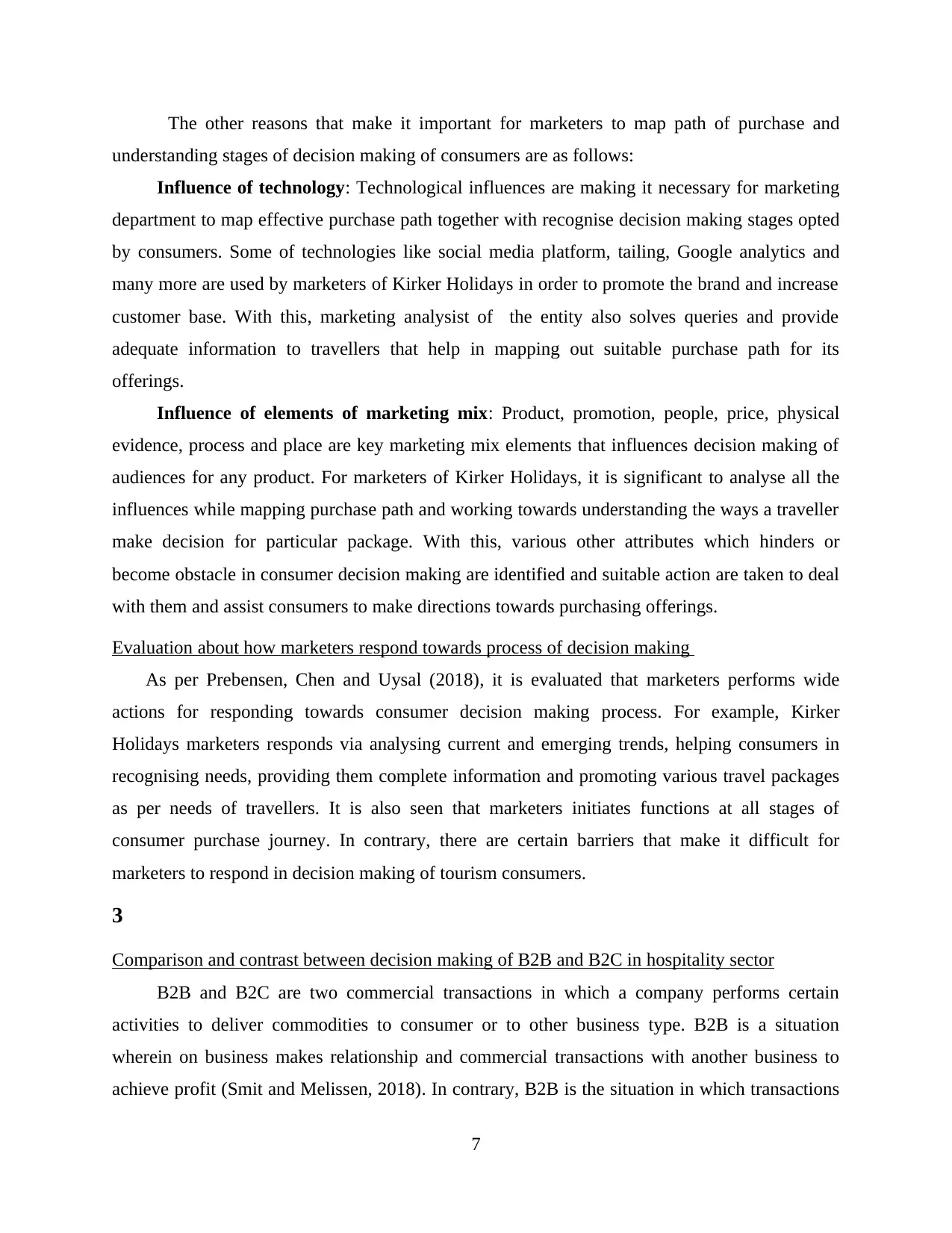
The other reasons that make it important for marketers to map path of purchase and
understanding stages of decision making of consumers are as follows:
Influence of technology: Technological influences are making it necessary for marketing
department to map effective purchase path together with recognise decision making stages opted
by consumers. Some of technologies like social media platform, tailing, Google analytics and
many more are used by marketers of Kirker Holidays in order to promote the brand and increase
customer base. With this, marketing analysist of the entity also solves queries and provide
adequate information to travellers that help in mapping out suitable purchase path for its
offerings.
Influence of elements of marketing mix: Product, promotion, people, price, physical
evidence, process and place are key marketing mix elements that influences decision making of
audiences for any product. For marketers of Kirker Holidays, it is significant to analyse all the
influences while mapping purchase path and working towards understanding the ways a traveller
make decision for particular package. With this, various other attributes which hinders or
become obstacle in consumer decision making are identified and suitable action are taken to deal
with them and assist consumers to make directions towards purchasing offerings.
Evaluation about how marketers respond towards process of decision making
As per Prebensen, Chen and Uysal (2018), it is evaluated that marketers performs wide
actions for responding towards consumer decision making process. For example, Kirker
Holidays marketers responds via analysing current and emerging trends, helping consumers in
recognising needs, providing them complete information and promoting various travel packages
as per needs of travellers. It is also seen that marketers initiates functions at all stages of
consumer purchase journey. In contrary, there are certain barriers that make it difficult for
marketers to respond in decision making of tourism consumers.
3
Comparison and contrast between decision making of B2B and B2C in hospitality sector
B2B and B2C are two commercial transactions in which a company performs certain
activities to deliver commodities to consumer or to other business type. B2B is a situation
wherein on business makes relationship and commercial transactions with another business to
achieve profit (Smit and Melissen, 2018). In contrary, B2B is the situation in which transactions
7
understanding stages of decision making of consumers are as follows:
Influence of technology: Technological influences are making it necessary for marketing
department to map effective purchase path together with recognise decision making stages opted
by consumers. Some of technologies like social media platform, tailing, Google analytics and
many more are used by marketers of Kirker Holidays in order to promote the brand and increase
customer base. With this, marketing analysist of the entity also solves queries and provide
adequate information to travellers that help in mapping out suitable purchase path for its
offerings.
Influence of elements of marketing mix: Product, promotion, people, price, physical
evidence, process and place are key marketing mix elements that influences decision making of
audiences for any product. For marketers of Kirker Holidays, it is significant to analyse all the
influences while mapping purchase path and working towards understanding the ways a traveller
make decision for particular package. With this, various other attributes which hinders or
become obstacle in consumer decision making are identified and suitable action are taken to deal
with them and assist consumers to make directions towards purchasing offerings.
Evaluation about how marketers respond towards process of decision making
As per Prebensen, Chen and Uysal (2018), it is evaluated that marketers performs wide
actions for responding towards consumer decision making process. For example, Kirker
Holidays marketers responds via analysing current and emerging trends, helping consumers in
recognising needs, providing them complete information and promoting various travel packages
as per needs of travellers. It is also seen that marketers initiates functions at all stages of
consumer purchase journey. In contrary, there are certain barriers that make it difficult for
marketers to respond in decision making of tourism consumers.
3
Comparison and contrast between decision making of B2B and B2C in hospitality sector
B2B and B2C are two commercial transactions in which a company performs certain
activities to deliver commodities to consumer or to other business type. B2B is a situation
wherein on business makes relationship and commercial transactions with another business to
achieve profit (Smit and Melissen, 2018). In contrary, B2B is the situation in which transactions
7
Paraphrase This Document
Need a fresh take? Get an instant paraphrase of this document with our AI Paraphraser
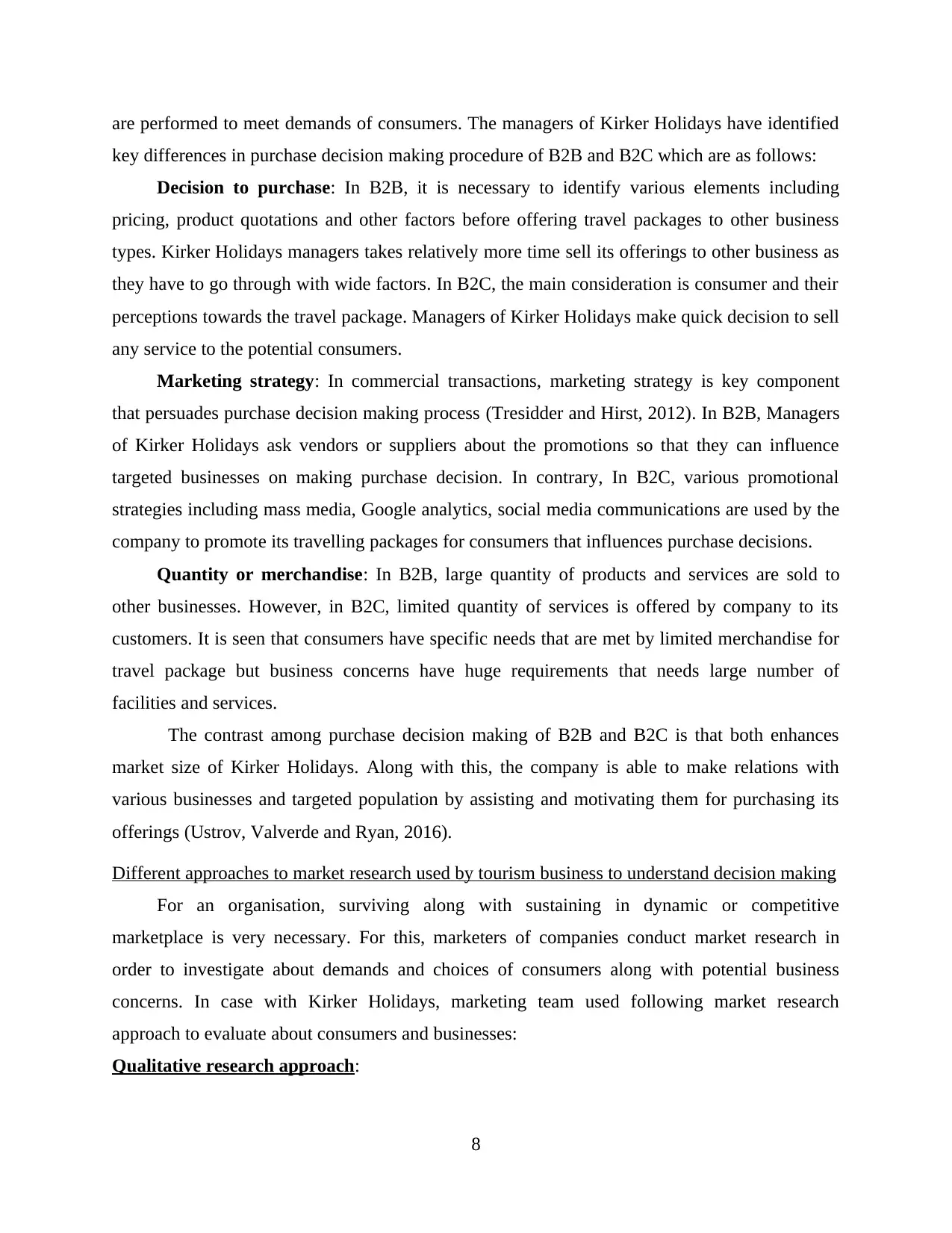
are performed to meet demands of consumers. The managers of Kirker Holidays have identified
key differences in purchase decision making procedure of B2B and B2C which are as follows:
Decision to purchase: In B2B, it is necessary to identify various elements including
pricing, product quotations and other factors before offering travel packages to other business
types. Kirker Holidays managers takes relatively more time sell its offerings to other business as
they have to go through with wide factors. In B2C, the main consideration is consumer and their
perceptions towards the travel package. Managers of Kirker Holidays make quick decision to sell
any service to the potential consumers.
Marketing strategy: In commercial transactions, marketing strategy is key component
that persuades purchase decision making process (Tresidder and Hirst, 2012). In B2B, Managers
of Kirker Holidays ask vendors or suppliers about the promotions so that they can influence
targeted businesses on making purchase decision. In contrary, In B2C, various promotional
strategies including mass media, Google analytics, social media communications are used by the
company to promote its travelling packages for consumers that influences purchase decisions.
Quantity or merchandise: In B2B, large quantity of products and services are sold to
other businesses. However, in B2C, limited quantity of services is offered by company to its
customers. It is seen that consumers have specific needs that are met by limited merchandise for
travel package but business concerns have huge requirements that needs large number of
facilities and services.
The contrast among purchase decision making of B2B and B2C is that both enhances
market size of Kirker Holidays. Along with this, the company is able to make relations with
various businesses and targeted population by assisting and motivating them for purchasing its
offerings (Ustrov, Valverde and Ryan, 2016).
Different approaches to market research used by tourism business to understand decision making
For an organisation, surviving along with sustaining in dynamic or competitive
marketplace is very necessary. For this, marketers of companies conduct market research in
order to investigate about demands and choices of consumers along with potential business
concerns. In case with Kirker Holidays, marketing team used following market research
approach to evaluate about consumers and businesses:
Qualitative research approach:
8
key differences in purchase decision making procedure of B2B and B2C which are as follows:
Decision to purchase: In B2B, it is necessary to identify various elements including
pricing, product quotations and other factors before offering travel packages to other business
types. Kirker Holidays managers takes relatively more time sell its offerings to other business as
they have to go through with wide factors. In B2C, the main consideration is consumer and their
perceptions towards the travel package. Managers of Kirker Holidays make quick decision to sell
any service to the potential consumers.
Marketing strategy: In commercial transactions, marketing strategy is key component
that persuades purchase decision making process (Tresidder and Hirst, 2012). In B2B, Managers
of Kirker Holidays ask vendors or suppliers about the promotions so that they can influence
targeted businesses on making purchase decision. In contrary, In B2C, various promotional
strategies including mass media, Google analytics, social media communications are used by the
company to promote its travelling packages for consumers that influences purchase decisions.
Quantity or merchandise: In B2B, large quantity of products and services are sold to
other businesses. However, in B2C, limited quantity of services is offered by company to its
customers. It is seen that consumers have specific needs that are met by limited merchandise for
travel package but business concerns have huge requirements that needs large number of
facilities and services.
The contrast among purchase decision making of B2B and B2C is that both enhances
market size of Kirker Holidays. Along with this, the company is able to make relations with
various businesses and targeted population by assisting and motivating them for purchasing its
offerings (Ustrov, Valverde and Ryan, 2016).
Different approaches to market research used by tourism business to understand decision making
For an organisation, surviving along with sustaining in dynamic or competitive
marketplace is very necessary. For this, marketers of companies conduct market research in
order to investigate about demands and choices of consumers along with potential business
concerns. In case with Kirker Holidays, marketing team used following market research
approach to evaluate about consumers and businesses:
Qualitative research approach:
8
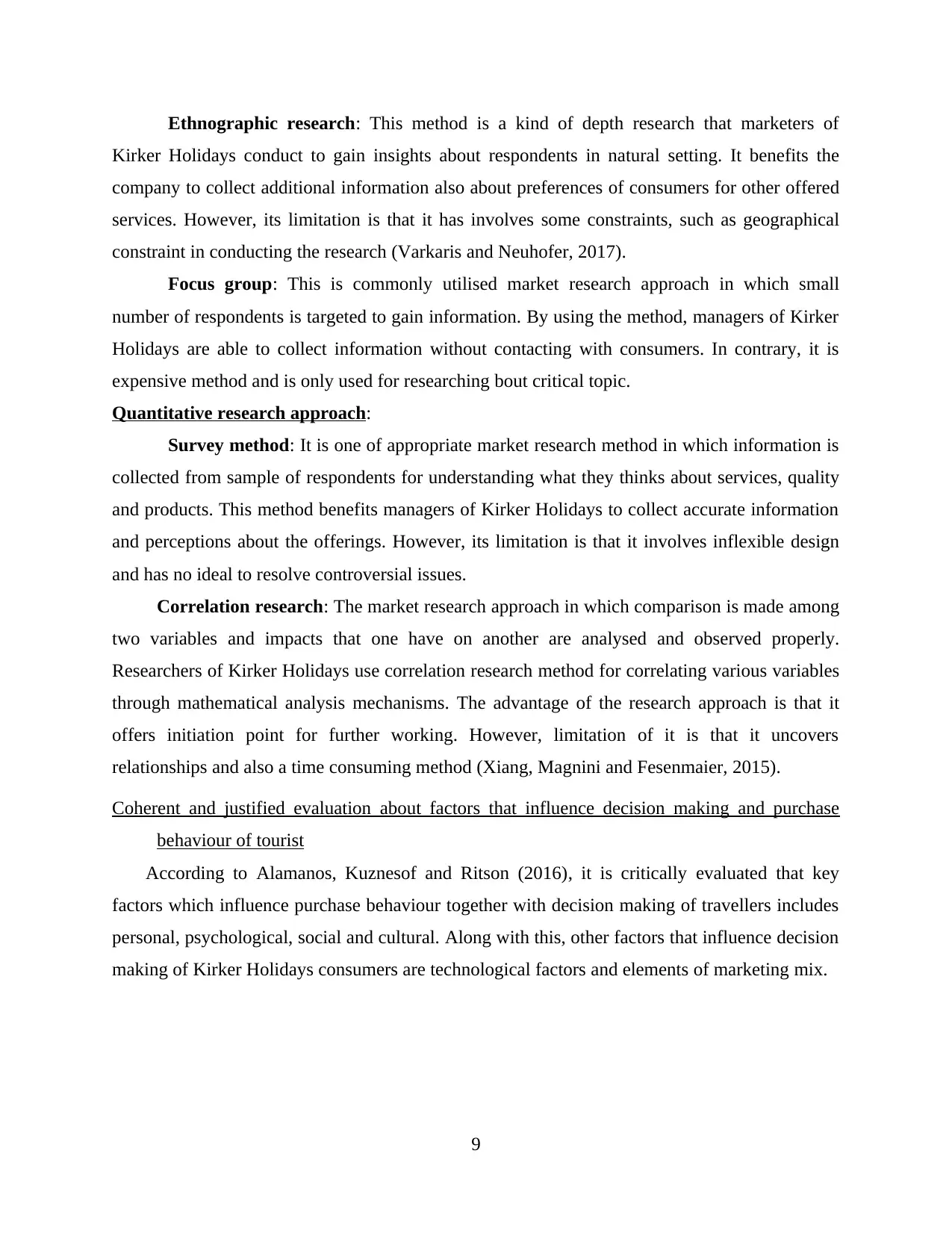
Ethnographic research: This method is a kind of depth research that marketers of
Kirker Holidays conduct to gain insights about respondents in natural setting. It benefits the
company to collect additional information also about preferences of consumers for other offered
services. However, its limitation is that it has involves some constraints, such as geographical
constraint in conducting the research (Varkaris and Neuhofer, 2017).
Focus group: This is commonly utilised market research approach in which small
number of respondents is targeted to gain information. By using the method, managers of Kirker
Holidays are able to collect information without contacting with consumers. In contrary, it is
expensive method and is only used for researching bout critical topic.
Quantitative research approach:
Survey method: It is one of appropriate market research method in which information is
collected from sample of respondents for understanding what they thinks about services, quality
and products. This method benefits managers of Kirker Holidays to collect accurate information
and perceptions about the offerings. However, its limitation is that it involves inflexible design
and has no ideal to resolve controversial issues.
Correlation research: The market research approach in which comparison is made among
two variables and impacts that one have on another are analysed and observed properly.
Researchers of Kirker Holidays use correlation research method for correlating various variables
through mathematical analysis mechanisms. The advantage of the research approach is that it
offers initiation point for further working. However, limitation of it is that it uncovers
relationships and also a time consuming method (Xiang, Magnini and Fesenmaier, 2015).
Coherent and justified evaluation about factors that influence decision making and purchase
behaviour of tourist
According to Alamanos, Kuznesof and Ritson (2016), it is critically evaluated that key
factors which influence purchase behaviour together with decision making of travellers includes
personal, psychological, social and cultural. Along with this, other factors that influence decision
making of Kirker Holidays consumers are technological factors and elements of marketing mix.
9
Kirker Holidays conduct to gain insights about respondents in natural setting. It benefits the
company to collect additional information also about preferences of consumers for other offered
services. However, its limitation is that it has involves some constraints, such as geographical
constraint in conducting the research (Varkaris and Neuhofer, 2017).
Focus group: This is commonly utilised market research approach in which small
number of respondents is targeted to gain information. By using the method, managers of Kirker
Holidays are able to collect information without contacting with consumers. In contrary, it is
expensive method and is only used for researching bout critical topic.
Quantitative research approach:
Survey method: It is one of appropriate market research method in which information is
collected from sample of respondents for understanding what they thinks about services, quality
and products. This method benefits managers of Kirker Holidays to collect accurate information
and perceptions about the offerings. However, its limitation is that it involves inflexible design
and has no ideal to resolve controversial issues.
Correlation research: The market research approach in which comparison is made among
two variables and impacts that one have on another are analysed and observed properly.
Researchers of Kirker Holidays use correlation research method for correlating various variables
through mathematical analysis mechanisms. The advantage of the research approach is that it
offers initiation point for further working. However, limitation of it is that it uncovers
relationships and also a time consuming method (Xiang, Magnini and Fesenmaier, 2015).
Coherent and justified evaluation about factors that influence decision making and purchase
behaviour of tourist
According to Alamanos, Kuznesof and Ritson (2016), it is critically evaluated that key
factors which influence purchase behaviour together with decision making of travellers includes
personal, psychological, social and cultural. Along with this, other factors that influence decision
making of Kirker Holidays consumers are technological factors and elements of marketing mix.
9
⊘ This is a preview!⊘
Do you want full access?
Subscribe today to unlock all pages.

Trusted by 1+ million students worldwide
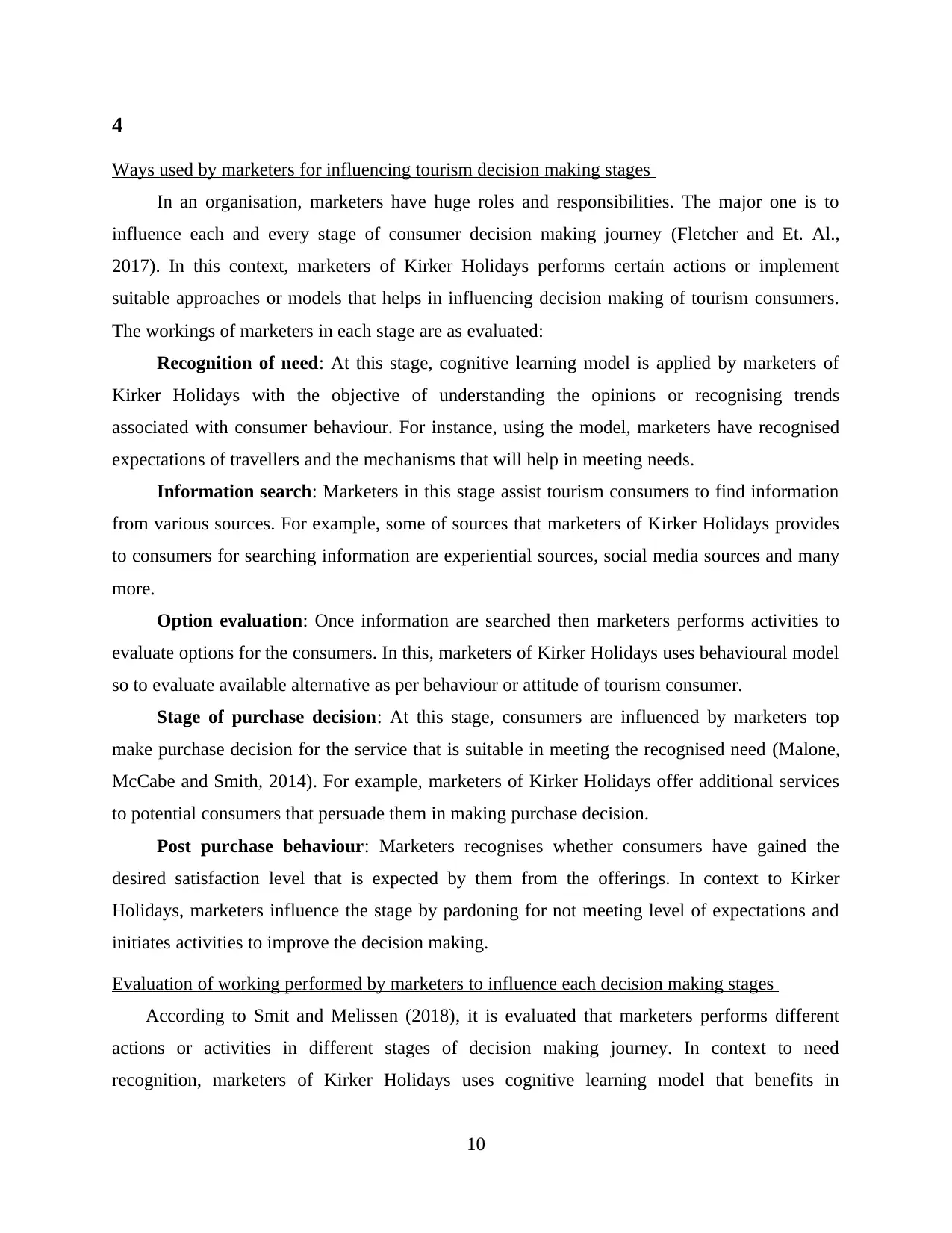
4
Ways used by marketers for influencing tourism decision making stages
In an organisation, marketers have huge roles and responsibilities. The major one is to
influence each and every stage of consumer decision making journey (Fletcher and Et. Al.,
2017). In this context, marketers of Kirker Holidays performs certain actions or implement
suitable approaches or models that helps in influencing decision making of tourism consumers.
The workings of marketers in each stage are as evaluated:
Recognition of need: At this stage, cognitive learning model is applied by marketers of
Kirker Holidays with the objective of understanding the opinions or recognising trends
associated with consumer behaviour. For instance, using the model, marketers have recognised
expectations of travellers and the mechanisms that will help in meeting needs.
Information search: Marketers in this stage assist tourism consumers to find information
from various sources. For example, some of sources that marketers of Kirker Holidays provides
to consumers for searching information are experiential sources, social media sources and many
more.
Option evaluation: Once information are searched then marketers performs activities to
evaluate options for the consumers. In this, marketers of Kirker Holidays uses behavioural model
so to evaluate available alternative as per behaviour or attitude of tourism consumer.
Stage of purchase decision: At this stage, consumers are influenced by marketers top
make purchase decision for the service that is suitable in meeting the recognised need (Malone,
McCabe and Smith, 2014). For example, marketers of Kirker Holidays offer additional services
to potential consumers that persuade them in making purchase decision.
Post purchase behaviour: Marketers recognises whether consumers have gained the
desired satisfaction level that is expected by them from the offerings. In context to Kirker
Holidays, marketers influence the stage by pardoning for not meeting level of expectations and
initiates activities to improve the decision making.
Evaluation of working performed by marketers to influence each decision making stages
According to Smit and Melissen (2018), it is evaluated that marketers performs different
actions or activities in different stages of decision making journey. In context to need
recognition, marketers of Kirker Holidays uses cognitive learning model that benefits in
10
Ways used by marketers for influencing tourism decision making stages
In an organisation, marketers have huge roles and responsibilities. The major one is to
influence each and every stage of consumer decision making journey (Fletcher and Et. Al.,
2017). In this context, marketers of Kirker Holidays performs certain actions or implement
suitable approaches or models that helps in influencing decision making of tourism consumers.
The workings of marketers in each stage are as evaluated:
Recognition of need: At this stage, cognitive learning model is applied by marketers of
Kirker Holidays with the objective of understanding the opinions or recognising trends
associated with consumer behaviour. For instance, using the model, marketers have recognised
expectations of travellers and the mechanisms that will help in meeting needs.
Information search: Marketers in this stage assist tourism consumers to find information
from various sources. For example, some of sources that marketers of Kirker Holidays provides
to consumers for searching information are experiential sources, social media sources and many
more.
Option evaluation: Once information are searched then marketers performs activities to
evaluate options for the consumers. In this, marketers of Kirker Holidays uses behavioural model
so to evaluate available alternative as per behaviour or attitude of tourism consumer.
Stage of purchase decision: At this stage, consumers are influenced by marketers top
make purchase decision for the service that is suitable in meeting the recognised need (Malone,
McCabe and Smith, 2014). For example, marketers of Kirker Holidays offer additional services
to potential consumers that persuade them in making purchase decision.
Post purchase behaviour: Marketers recognises whether consumers have gained the
desired satisfaction level that is expected by them from the offerings. In context to Kirker
Holidays, marketers influence the stage by pardoning for not meeting level of expectations and
initiates activities to improve the decision making.
Evaluation of working performed by marketers to influence each decision making stages
According to Smit and Melissen (2018), it is evaluated that marketers performs different
actions or activities in different stages of decision making journey. In context to need
recognition, marketers of Kirker Holidays uses cognitive learning model that benefits in
10
Paraphrase This Document
Need a fresh take? Get an instant paraphrase of this document with our AI Paraphraser
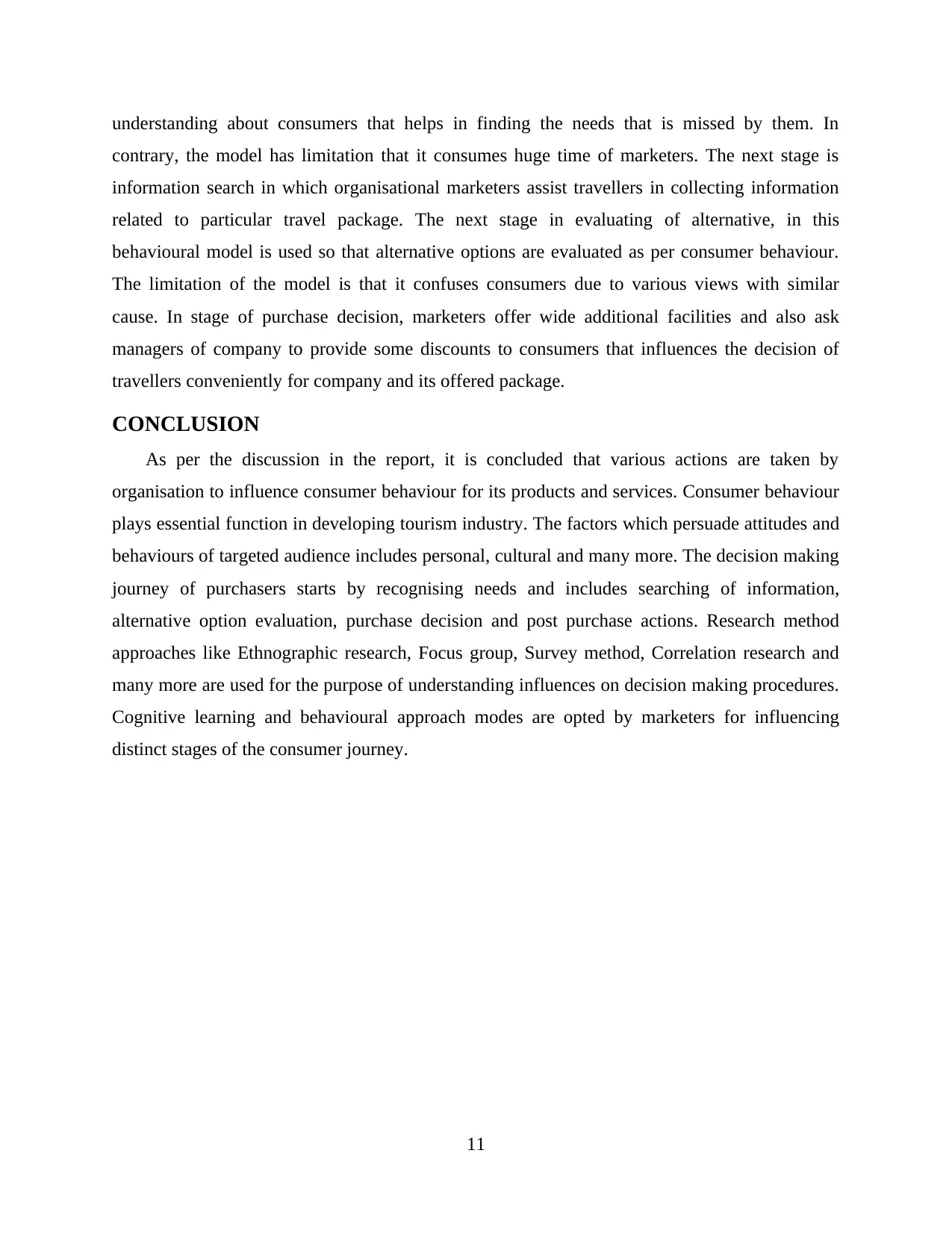
understanding about consumers that helps in finding the needs that is missed by them. In
contrary, the model has limitation that it consumes huge time of marketers. The next stage is
information search in which organisational marketers assist travellers in collecting information
related to particular travel package. The next stage in evaluating of alternative, in this
behavioural model is used so that alternative options are evaluated as per consumer behaviour.
The limitation of the model is that it confuses consumers due to various views with similar
cause. In stage of purchase decision, marketers offer wide additional facilities and also ask
managers of company to provide some discounts to consumers that influences the decision of
travellers conveniently for company and its offered package.
CONCLUSION
As per the discussion in the report, it is concluded that various actions are taken by
organisation to influence consumer behaviour for its products and services. Consumer behaviour
plays essential function in developing tourism industry. The factors which persuade attitudes and
behaviours of targeted audience includes personal, cultural and many more. The decision making
journey of purchasers starts by recognising needs and includes searching of information,
alternative option evaluation, purchase decision and post purchase actions. Research method
approaches like Ethnographic research, Focus group, Survey method, Correlation research and
many more are used for the purpose of understanding influences on decision making procedures.
Cognitive learning and behavioural approach modes are opted by marketers for influencing
distinct stages of the consumer journey.
11
contrary, the model has limitation that it consumes huge time of marketers. The next stage is
information search in which organisational marketers assist travellers in collecting information
related to particular travel package. The next stage in evaluating of alternative, in this
behavioural model is used so that alternative options are evaluated as per consumer behaviour.
The limitation of the model is that it confuses consumers due to various views with similar
cause. In stage of purchase decision, marketers offer wide additional facilities and also ask
managers of company to provide some discounts to consumers that influences the decision of
travellers conveniently for company and its offered package.
CONCLUSION
As per the discussion in the report, it is concluded that various actions are taken by
organisation to influence consumer behaviour for its products and services. Consumer behaviour
plays essential function in developing tourism industry. The factors which persuade attitudes and
behaviours of targeted audience includes personal, cultural and many more. The decision making
journey of purchasers starts by recognising needs and includes searching of information,
alternative option evaluation, purchase decision and post purchase actions. Research method
approaches like Ethnographic research, Focus group, Survey method, Correlation research and
many more are used for the purpose of understanding influences on decision making procedures.
Cognitive learning and behavioural approach modes are opted by marketers for influencing
distinct stages of the consumer journey.
11
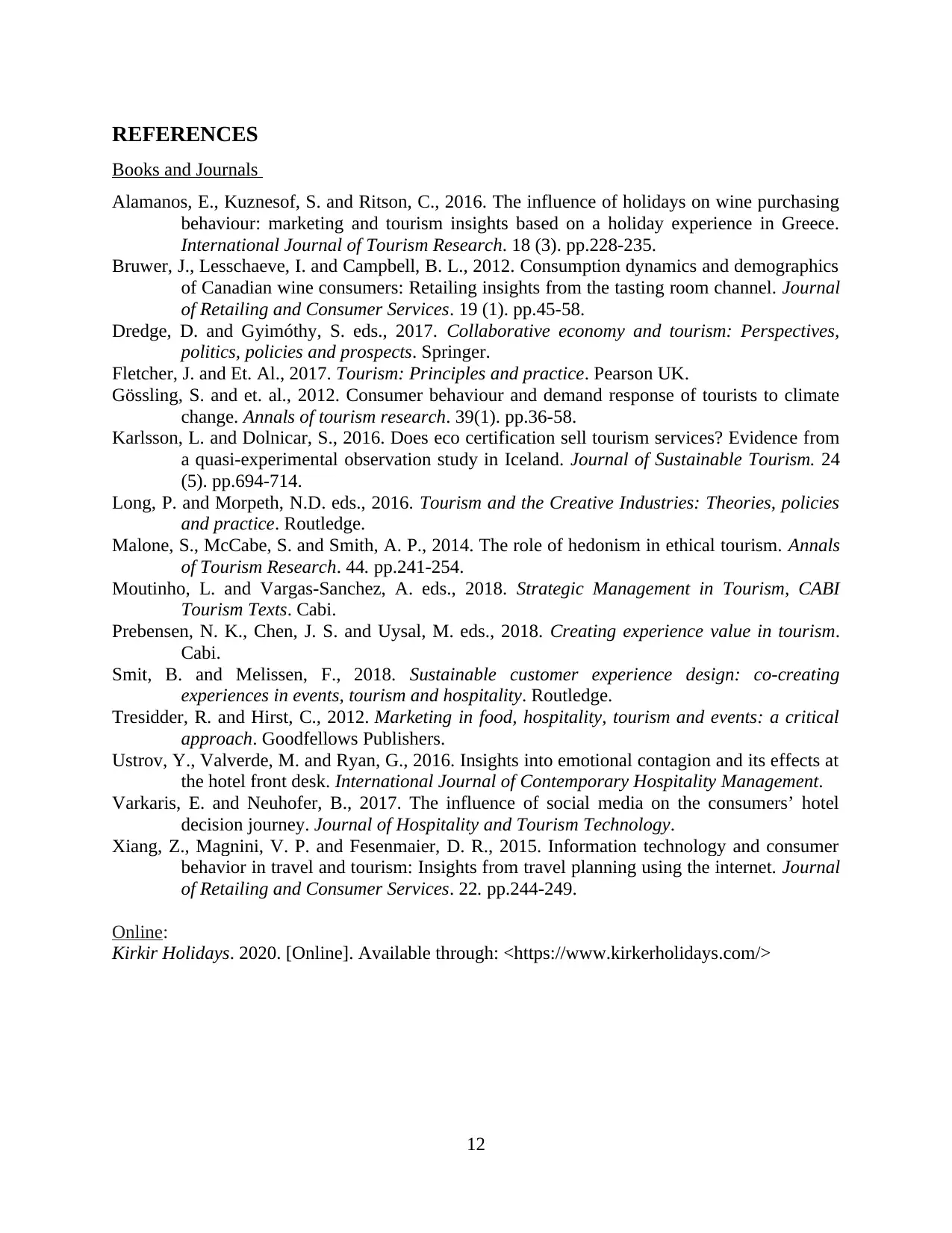
REFERENCES
Books and Journals
Alamanos, E., Kuznesof, S. and Ritson, C., 2016. The influence of holidays on wine purchasing
behaviour: marketing and tourism insights based on a holiday experience in Greece.
International Journal of Tourism Research. 18 (3). pp.228-235.
Bruwer, J., Lesschaeve, I. and Campbell, B. L., 2012. Consumption dynamics and demographics
of Canadian wine consumers: Retailing insights from the tasting room channel. Journal
of Retailing and Consumer Services. 19 (1). pp.45-58.
Dredge, D. and Gyimóthy, S. eds., 2017. Collaborative economy and tourism: Perspectives,
politics, policies and prospects. Springer.
Fletcher, J. and Et. Al., 2017. Tourism: Principles and practice. Pearson UK.
Gössling, S. and et. al., 2012. Consumer behaviour and demand response of tourists to climate
change. Annals of tourism research. 39(1). pp.36-58.
Karlsson, L. and Dolnicar, S., 2016. Does eco certification sell tourism services? Evidence from
a quasi-experimental observation study in Iceland. Journal of Sustainable Tourism. 24
(5). pp.694-714.
Long, P. and Morpeth, N.D. eds., 2016. Tourism and the Creative Industries: Theories, policies
and practice. Routledge.
Malone, S., McCabe, S. and Smith, A. P., 2014. The role of hedonism in ethical tourism. Annals
of Tourism Research. 44. pp.241-254.
Moutinho, L. and Vargas-Sanchez, A. eds., 2018. Strategic Management in Tourism, CABI
Tourism Texts. Cabi.
Prebensen, N. K., Chen, J. S. and Uysal, M. eds., 2018. Creating experience value in tourism.
Cabi.
Smit, B. and Melissen, F., 2018. Sustainable customer experience design: co-creating
experiences in events, tourism and hospitality. Routledge.
Tresidder, R. and Hirst, C., 2012. Marketing in food, hospitality, tourism and events: a critical
approach. Goodfellows Publishers.
Ustrov, Y., Valverde, M. and Ryan, G., 2016. Insights into emotional contagion and its effects at
the hotel front desk. International Journal of Contemporary Hospitality Management.
Varkaris, E. and Neuhofer, B., 2017. The influence of social media on the consumers’ hotel
decision journey. Journal of Hospitality and Tourism Technology.
Xiang, Z., Magnini, V. P. and Fesenmaier, D. R., 2015. Information technology and consumer
behavior in travel and tourism: Insights from travel planning using the internet. Journal
of Retailing and Consumer Services. 22. pp.244-249.
Online:
Kirkir Holidays. 2020. [Online]. Available through: <https://www.kirkerholidays.com/>
12
Books and Journals
Alamanos, E., Kuznesof, S. and Ritson, C., 2016. The influence of holidays on wine purchasing
behaviour: marketing and tourism insights based on a holiday experience in Greece.
International Journal of Tourism Research. 18 (3). pp.228-235.
Bruwer, J., Lesschaeve, I. and Campbell, B. L., 2012. Consumption dynamics and demographics
of Canadian wine consumers: Retailing insights from the tasting room channel. Journal
of Retailing and Consumer Services. 19 (1). pp.45-58.
Dredge, D. and Gyimóthy, S. eds., 2017. Collaborative economy and tourism: Perspectives,
politics, policies and prospects. Springer.
Fletcher, J. and Et. Al., 2017. Tourism: Principles and practice. Pearson UK.
Gössling, S. and et. al., 2012. Consumer behaviour and demand response of tourists to climate
change. Annals of tourism research. 39(1). pp.36-58.
Karlsson, L. and Dolnicar, S., 2016. Does eco certification sell tourism services? Evidence from
a quasi-experimental observation study in Iceland. Journal of Sustainable Tourism. 24
(5). pp.694-714.
Long, P. and Morpeth, N.D. eds., 2016. Tourism and the Creative Industries: Theories, policies
and practice. Routledge.
Malone, S., McCabe, S. and Smith, A. P., 2014. The role of hedonism in ethical tourism. Annals
of Tourism Research. 44. pp.241-254.
Moutinho, L. and Vargas-Sanchez, A. eds., 2018. Strategic Management in Tourism, CABI
Tourism Texts. Cabi.
Prebensen, N. K., Chen, J. S. and Uysal, M. eds., 2018. Creating experience value in tourism.
Cabi.
Smit, B. and Melissen, F., 2018. Sustainable customer experience design: co-creating
experiences in events, tourism and hospitality. Routledge.
Tresidder, R. and Hirst, C., 2012. Marketing in food, hospitality, tourism and events: a critical
approach. Goodfellows Publishers.
Ustrov, Y., Valverde, M. and Ryan, G., 2016. Insights into emotional contagion and its effects at
the hotel front desk. International Journal of Contemporary Hospitality Management.
Varkaris, E. and Neuhofer, B., 2017. The influence of social media on the consumers’ hotel
decision journey. Journal of Hospitality and Tourism Technology.
Xiang, Z., Magnini, V. P. and Fesenmaier, D. R., 2015. Information technology and consumer
behavior in travel and tourism: Insights from travel planning using the internet. Journal
of Retailing and Consumer Services. 22. pp.244-249.
Online:
Kirkir Holidays. 2020. [Online]. Available through: <https://www.kirkerholidays.com/>
12
⊘ This is a preview!⊘
Do you want full access?
Subscribe today to unlock all pages.

Trusted by 1+ million students worldwide
1 out of 12
Related Documents
Your All-in-One AI-Powered Toolkit for Academic Success.
+13062052269
info@desklib.com
Available 24*7 on WhatsApp / Email
![[object Object]](/_next/static/media/star-bottom.7253800d.svg)
Unlock your academic potential
Copyright © 2020–2025 A2Z Services. All Rights Reserved. Developed and managed by ZUCOL.



